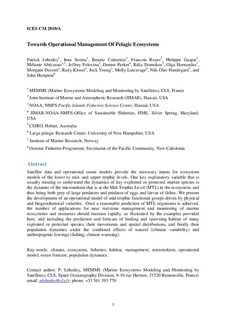| dc.contributor.author | Lehodey, Patrick | |
| dc.contributor.author | Senina, Inna | |
| dc.contributor.author | Calmettes, Beatriz | |
| dc.contributor.author | Royer, Francois | |
| dc.contributor.author | Gaspar, Philippe | |
| dc.contributor.author | Abécassis, Mélanie | |
| dc.contributor.author | Polovina, Jeffrey | |
| dc.contributor.author | Parker, Denise | |
| dc.contributor.author | Domokos, Réka | |
| dc.contributor.author | Hernandez, Olga | |
| dc.contributor.author | Dessert, Morgane | |
| dc.contributor.author | Kloser, Rudy | |
| dc.contributor.author | Young, Jock | |
| dc.contributor.author | Lutcavage, Molly | |
| dc.contributor.author | Handegard, Nils Olav | |
| dc.contributor.author | Hampton, John | |
| dc.date.accessioned | 2011-02-25T13:51:34Z | |
| dc.date.available | 2011-02-25T13:51:34Z | |
| dc.date.issued | 2010 | |
| dc.identifier.citation | This report is not to be quoted without prior consultation with the General Secretary. | en_US |
| dc.identifier.uri | http://hdl.handle.net/11250/102140 | |
| dc.description.abstract | Satellite data and operational ocean models provide the necessary inputs for ecosystem models of the lower to mid- and upper trophic levels. One key explanatory variable that is usually missing to understand the dynamics of key exploited or protected marine species is the dynamic of the micronekton that is at the Mid-Trophic Level (MTL) in the ecosystem, and
thus being both prey of large predators and predator of eggs and larvae of fishes. We present the development of an operational model of mid-trophic functional groups driven by physical
and biogeochemical variables. Once a reasonable prediction of MTL organisms is achieved, the number of applications for near real-time management and monitoring of marine ecosystems and resources should increase rapidly, as illustrated by the examples provided
here, and including the prediction and forecast of feeding and spawning habitat of many exploited or protected species, their movements and spatial distributions, and finally their population dynamics under the combined effects of natural (climate variability) and anthropogenic forcings (fishing, climate warming). | en_US |
| dc.language.iso | eng | en_US |
| dc.publisher | ICES | en_US |
| dc.relation.ispartofseries | ICES CM documents;2010/A:04 | |
| dc.subject | ecosystems | en_US |
| dc.subject | økosystemer | en_US |
| dc.subject | habitat | en_US |
| dc.subject | habitat | en_US |
| dc.subject | climate | en_US |
| dc.subject | klima | en_US |
| dc.subject | population dynamics | en_US |
| dc.subject | populasjonsdynamikk | en_US |
| dc.title | Towards Operational Management Of Pelagic Ecosystems | en_US |
| dc.type | Working paper | en_US |
| dc.subject.nsi | VDP::Mathematics and natural science: 400::Zoology and botany: 480::Ecology: 488 | en_US |
| dc.source.pagenumber | 13 s. | en_US |
